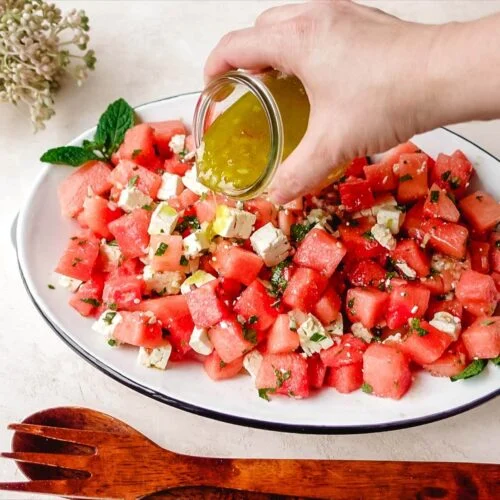Nothing screams summer like a vibrant, zesty mixed citrus salad with feta and mint. This dish is a burst of sunshine on a plate, combining the tangy sweetness of citrus fruits with the creamy saltiness of feta and the refreshing pop of fresh mint. I first stumbled upon this recipe during a family gathering when my cousin, a self-proclaimed foodie, brought it to the table, and it was love at first bite. In this 2,500-word guide, I’ll share everything you need to know to create this crowd-pleasing salad, from selecting the best ingredients to mastering presentation. Packed with tips, variations, and nutritional insights, this article will inspire you to make this dish a staple in your kitchen, whether you’re hosting a dinner party or craving a healthy lunch.
Why Mixed Citrus Salad Shines
This salad isn’t just a feast for your taste buds—it’s a nutritional powerhouse and a visual stunner. The combination of citrus fruits, feta, and mint creates a balance of flavors that’s both refreshing and satisfying. Plus, it’s versatile enough for any season, though it’s especially perfect for warm days when you want something light yet flavorful.
A Perfect Blend of Flavors
The sweet-tart citrus fruits, creamy feta, and aromatic mint create a symphony of tastes and textures. The salad’s bright colors and fresh ingredients make it as Instagram-worthy as it is delicious. It’s the kind of dish that feels fancy but takes minimal effort.
My Citrus Salad Story
Last summer, I hosted a backyard barbecue and wanted a side dish that would wow my guests without hours of prep. Inspired by my cousin’s recipe, I tossed together a citrus salad with oranges, grapefruit, and a sprinkle of feta. The mint was the game-changer—everyone raved about it, and I’ve been hooked ever since.
Ingredients for the Perfect Citrus Salad
Selecting high-quality ingredients is the key to making this salad sing. From juicy citrus fruits to the right feta, each component plays a role in creating a harmonious dish. Let’s break down what you’ll need and how to choose the best options.
1. Choosing the Best Citrus Fruits
Opt for a mix of citrus fruits like oranges, grapefruits, blood oranges, and tangerines for variety in flavor and color. Look for fruits that are firm, heavy for their size, and free of blemishes. Seasonal citrus, available from late fall to early spring, is often the freshest and most affordable.
Where to Source Citrus
Shop at local farmers’ markets or grocery stores like Whole Foods for organic options. Websites like LocalHarvest can connect you with nearby citrus growers for peak freshness.
2. Selecting the Right Feta
Feta adds a creamy, salty contrast to the citrus. Choose a block of feta packed in brine over pre-crumbled varieties for better flavor and texture. Greek or Bulgarian feta offers a tangy bite, while French feta is milder and creamier.
Feta Comparison Table
| Type | Flavor Profile | Texture | Best For |
|---|---|---|---|
| Greek Feta | Tangy, salty | Firm, crumbly | Bold contrast |
| Bulgarian Feta | Sharp, creamy | Soft, spreadable | Richer dishes |
| French Feta | Mild, creamy | Smooth | Subtle pairing |
3. Fresh Mint: The Secret Weapon
Fresh mint leaves elevate the salad with a cooling, aromatic touch. Avoid dried mint—it lacks the vibrancy. Look for bright, unblemished leaves at grocery stores or grow your own using kits from sites like Burpee.
Growing Your Own Mint
Mint is easy to grow in pots or gardens, thriving in partial shade. Snip fresh leaves as needed, and you’ll have a steady supply for salads, drinks, and more.
4. Supporting Ingredients
A simple dressing of olive oil, honey, and lemon juice ties the salad together. Add red onion for a sharp crunch and pistachios for nutty texture. Always use extra-virgin olive oil for the best flavor.
Shopping List
- 2 oranges (navel or blood)
- 1 grapefruit
- 2 tangerines
- 4 oz feta cheese
- ¼ cup fresh mint leaves
- ¼ red onion, thinly sliced
- ¼ cup pistachios, chopped
- 3 tbsp extra-virgin olive oil
- 1 tbsp honey
- 1 tbsp lemon juice
- Salt and pepper to taste
Step-by-Step Recipe for Mixed Citrus Salad
This recipe serves 4–6 and takes about 15 minutes to prepare. It’s simple enough for beginners but impressive enough for seasoned cooks. Follow these steps to create a salad that’s as beautiful as it is delicious.
5. Prepare the Citrus Fruits
Peel and segment the oranges, grapefruit, and tangerines, removing as much pith as possible. Use a sharp knife to cut supremes (seedless, membrane-free segments) for a professional look. Arrange the segments on a large platter for a stunning presentation.
Pro Tip for Supreming
Hold the fruit over a bowl to catch juices, which you can add to the dressing for extra flavor. Practice makes perfect—my first attempt was messy, but it still tasted amazing!
6. Make the Dressing
Whisk together olive oil, honey, lemon juice, a pinch of salt, and a dash of pepper in a small bowl. Taste and adjust the sweetness or acidity as needed. Drizzle lightly over the citrus to avoid overpowering the natural flavors.
Dressing Variations
- Spicy Kick: Add a pinch of red pepper flakes.
- Herbaceous Twist: Mix in chopped basil or cilantro.
- Creamy Option: Blend in a tablespoon of Greek yogurt.
7. Assemble the Salad
Scatter crumbled feta, sliced red onion, chopped pistachios, and torn mint leaves over the citrus segments. Drizzle the dressing evenly, ensuring every bite has a balance of flavors. Serve immediately for maximum freshness.
Presentation Tips
Use a white or colorful platter to make the citrus pop. Garnish with extra mint sprigs for a restaurant-worthy look. I once served this at a brunch, and guests thought I’d hired a caterer!
8. Store Leftovers Properly
If you have leftovers (unlikely!), store them in an airtight container in the fridge for up to 2 days. The citrus may release more juice, so drain before serving again to maintain texture.
Storage Do’s and Don’ts
- Do: Keep components separate if prepping ahead.
- Don’t: Add dressing until ready to serve to avoid sogginess.
Nutritional Benefits of Citrus Salad
This salad isn’t just delicious—it’s packed with health benefits. Citrus fruits are loaded with vitamin C, fiber, and antioxidants, while feta adds protein and calcium. Let’s dive into why this dish is a nutritional winner.
9. Vitamin C Powerhouse
A single orange provides about 70 mg of vitamin C, nearly meeting the daily recommended intake (75–90 mg for adults). This boosts immunity and supports skin health, perfect for staying vibrant year-round.
Citrus Nutrition Breakdown
| Fruit | Vitamin C (mg) | Fiber (g) | Calories |
|---|---|---|---|
| Orange | 70 | 3 | 60 |
| Grapefruit | 38 | 2 | 50 |
| Tangerine | 26 | 1.8 | 47 |
10. Feta’s Protein and Calcium Boost
Feta provides 4 grams of protein and 140 mg of calcium per ounce, supporting muscle and bone health. Its strong flavor means a little goes a long way, keeping the calorie count low.
Health Tip
Opt for reduced-fat feta if you’re watching calories, but use sparingly to maintain flavor balance. I learned this the hard way when I overdid it and drowned out the citrus!
11. Mint’s Digestive Benefits
Mint aids digestion and adds a refreshing note that complements the citrus. Studies, like one from the National Institutes of Health, suggest mint may soothe stomach discomfort, making this salad a great post-meal option.
Incorporating Mint Daily
Add mint to water, teas, or smoothies for a health boost. It’s a small change that makes a big difference, especially after heavy meals.
Customizing Your Citrus Salad
One of the best things about this salad is its versatility. You can tweak it to suit your tastes, dietary needs, or what’s in your pantry. Here are some ideas to make it your own.
12. Add Protein for a Main Dish
Turn the salad into a full meal by adding grilled chicken, shrimp, or chickpeas. A 4-ounce serving of grilled chicken adds about 25 grams of protein, making it a satisfying lunch or dinner.
Protein Pairings
- Chicken: Light and versatile, pairs well with citrus.
- Shrimp: Adds a seafood twist, great for summer.
- Chickpeas: Vegan-friendly, adds texture and fiber.
13. Swap Citrus for Seasonal Fruits
If citrus isn’t in season, try fruits like pomegranate, mango, or berries. Each brings a unique flavor profile while keeping the salad vibrant and fresh.
Seasonal Fruit Alternatives
- Winter: Pomegranate seeds for a jewel-like pop.
- Summer: Mango slices for tropical sweetness.
- Fall: Persimmons for a subtle, honeyed flavor.
14. Make It Vegan
Replace feta with vegan cheese or toasted nuts like almonds for a dairy-free option. Brands like Violife offer feta-style vegan cheese that mimics the salty tang.
Vegan Cheese Pros and Cons
- Pros: Dairy-free, cruelty-free, similar flavor.
- Cons: May be pricier, less creamy texture.
Tools and Tips for Success
Creating a perfect citrus salad doesn’t require fancy equipment, but a few tools and tricks can elevate your game. Here’s what you need and how to use it effectively.
15. Essential Kitchen Tools
A sharp paring knife, cutting board, and whisk are all you need for prep. A citrus zester can add flair if you want to garnish with zest, and a mandoline makes quick work of slicing red onions.
Best Tools for Salad Prep
- Paring Knife: Victorinox for precise supreming.
- Mandoline: OXO for thin, even slices.
- Whisk: A small silicone whisk for smooth dressing.
16. Time-Saving Hacks
Buy pre-segmented citrus from stores like Trader Joe’s to save time. You can also prep the dressing a day ahead and store it in the fridge. Chop mint and pistachios in bulk for quick assembly.
My Time-Saver Story
I once prepped this salad for a potluck in under 10 minutes by using pre-cut citrus and a pre-made dressing. It was a lifesaver when I was running late but still wanted to impress!
17. Pairing Suggestions
Serve the salad with grilled fish, roasted chicken, or a crusty baguette for a complete meal. For drinks, pair with a crisp white wine like Sauvignon Blanc or a sparkling water with lemon.
Perfect Pairings
- Main Dish: Grilled salmon with herb sauce.
- Side: Quinoa or couscous for added texture.
- Drink: Sparkling water with a mint sprig.
People Also Ask (PAA) Section
What is a mixed citrus salad?
A mixed citrus salad combines various citrus fruits like oranges, grapefruits, and tangerines with ingredients like feta and mint. It’s a light, refreshing dish perfect for summer or as a side. The dressing, often olive oil and honey, enhances the natural flavors.
How do I make a citrus salad dressing?
Whisk together 3 tablespoons extra-virgin olive oil, 1 tablespoon honey, 1 tablespoon lemon juice, and a pinch of salt and pepper. Adjust sweetness or acidity to taste. Drizzle sparingly to let the citrus shine.
Where can I buy fresh citrus fruits?
Local farmers’ markets, grocery stores like Whole Foods, or online platforms like LocalHarvest offer fresh, seasonal citrus. Look for firm, heavy fruits for the best flavor.
What are the best substitutes for feta in a salad?
Try goat cheese, queso fresco, or vegan feta like Violife for a similar salty, creamy texture. For non-dairy options, toasted nuts or seeds add crunch and flavor.
FAQ Section
How do I choose the best citrus fruits for a salad?
Look for fruits that are firm, heavy, and free of soft spots or blemishes. Seasonal citrus (November–April) is often the freshest. Smell the fruit—a strong, sweet aroma indicates ripeness.
Can I make a citrus salad ahead of time?
Yes, but assemble just before serving to avoid sogginess. Prep citrus segments and dressing up to a day ahead, storing them separately in the fridge. Add feta and mint at the last minute.
Is a mixed citrus salad healthy?
Absolutely! It’s rich in vitamin C, fiber, and antioxidants from citrus, plus protein and calcium from feta. A single serving (about 1 cup) is under 200 calories, making it a nutritious choice.
What can I use instead of mint?
Try basil, cilantro, or parsley for a different herbaceous note. Each offers a unique flavor, with basil being sweeter and cilantro more citrusy. Adjust quantities to taste.
How do I make a citrus salad vegan?
Swap feta for vegan cheese like Violife or use nuts like almonds or walnuts for texture. Ensure the dressing is honey-free by using agave or maple syrup instead.
Conclusion: Brighten Your Table with Citrus Salad
A mixed citrus salad with feta and mint is more than just a dish—it’s a celebration of fresh, vibrant flavors that anyone can master. Whether you’re inspired by my barbecue success or ready to experiment with your own twists, this recipe is your ticket to a healthy, delicious meal that impresses every time. Grab some citrus, crumble some feta, and let the mint work its magic. Visit Bon Appétit for more salad inspiration, or share your creation on social media with #CitrusSaladLove. What’s your favorite way to enjoy this zesty dish?


